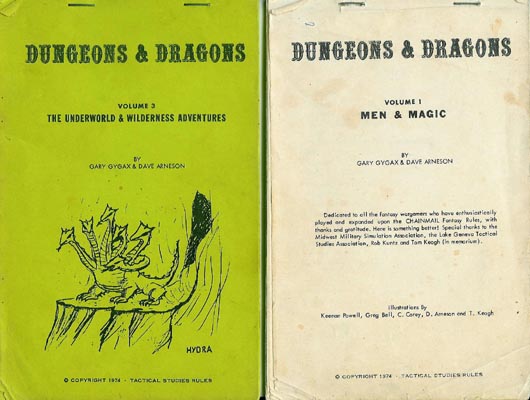|
Return to Essay section
A Worthless Treasure ByTHE SCRIBEHow many times have we ran across something in our collectible travels that tells
After some time, they finally arrived in the mail. I looked them over just long enough to realize they were indeed some type of photocopy. But they truly were as old as any material in my collection from OD&D line of product. They were indeed perfectly cut. The staple on top of both of the copies were indeed made mechanically, albeit however crude the mechanical system was the staples lined up perfectly from copy to copy. I finally came back to these to compare with all of my other authentic copies. These were actually copied from the original first printings in 1974, not any of the later reprints nor the faux originals from the OCE sets in the late 70's. The Men and Magic item mentioned Hobbits and Ents and had the more difficult to read typeface on the interior absent from the latest copies and the only mention of printing date is 1974. So this could lead me to only one logical conclusion that may carry, if nothing else, a perspective into the earliest days of role playing games. Only a thousand copies of the original boxset were made. This was considered quite a few at the time as most new games only sold a few hundred at best. Gygax and company knew they had a hit when they began to print and assemble these first printings from his basement. Unfortunately, they had no idea how huge a hit they would be. Word spread like a firestorm about this new game called Dungeons and Dragons. Everyone was eager to get their hands on a set so that they could too play it. The folks at the newly formed TSR in the Gygax basement could not make these fast enough and in large enough quantities. Gamers had to take matters into their own hands. There are many reports from industry folks through the years of what extent they had to go through to finally get a set of rules from 1974-75 and beyond. The most effective way to share was to bust open the books and copy them for friends. My copies last place of existence was on the East Coast which further supports my suspicions about what occurred. Being from the Midwest, the first batch of D&D did not extend very far from the core fantasy gaming group Gygax and Co. had developed in the region. Surely, folks in metropolitan areas would hear of this terrific new game. Copies had to be made to fill this demand. What remains perplexing is that the rules are indeed perfectly cut and mechanically stapled. Why would someone's buddy go through so much work for a set or two? Perhaps this set was an official copy of the original ruleset to meet demand? Maybe this set existed prior to the existence of the first printings release? Maybe beta sets were passed around before the first printing returned from the printers? I wrote the seller to report that I believed the set to be copies but I found them to be interesting just the same from a theoretical standpoint. I asked the seller where he had acquired these as this could help me with my research. He said he saved them from the paper recycling pile in the basement of his Manhattan apartment building. He had never played the game but having had been on Ebay before he figured he might as well try to turn a profit on someone else's trash. Well, he made a few bucks off of me but I think the speculative value of these surely was worth the risk. Of trash or treasure, I am still not sure. There are not that many people who have even seen an original of the 1st printing rules set much less a well crafted copy from someone who actually owned one back in 1974. Perhaps others know more of where these originated and why they were made? Perhaps time will tell or the truth is lost to history. The Scribe - April, 2004 |

 They indeed did look to be perfectly cut. They were staple at the top of the booklet in a tablet form. The staples appeared to be identically aligned in both of the of the booklets as if they were mechanically stapled. What really caught my interest was that they were nearly a half of an inch longer than the original booklets.
They indeed did look to be perfectly cut. They were staple at the top of the booklet in a tablet form. The staples appeared to be identically aligned in both of the of the booklets as if they were mechanically stapled. What really caught my interest was that they were nearly a half of an inch longer than the original booklets.